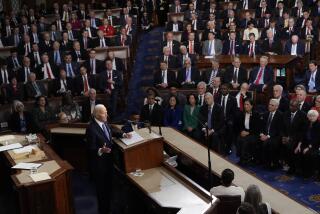Job growth slows in 2016, but wages are rising
The U.S. economy finished 2016 with a slowdown in job growth but a surge in wage gains, a mixed picture that has come to mark President Obama’s stewardship of the nation’s long but relatively weak recovery from the Great Recession.
Employers added 156,000 jobs in December — the 75th straight month of job creation and the longest stretch since record-keeping began in 1939, the Labor Department said Friday.
The nation’s payrolls have grown by about 10.5 million since Obama took office eight years ago. That’s more than under President George W. Bush’s two terms, but a little less than half the job creation during President Clinton’s tenure.
The 4.7% December unemployment rate, although up a notch from November, is about where it was before the financial crisis erupted in late 2007.
President-elect Donald Trump has pledged to boost the nation’s modest pace of economic growth with lower taxes, cuts in business regulations and incentives to spur infrastructure investments.
But as he enters the White House, Trump faces an economy that is already at or close to full employment, making it increasingly hard to keep up a high rate of job growth.
Thanks partly to a tighter labor market, weak global economy and strong dollar, job growth slowed last year to a monthly average of 180,000, down from about 230,000 in 2015 and 250,000 in 2014.
Still, Harry Holzer, a professor at Georgetown University and former Labor Department chief economist under Clinton, said Trump would be “inheriting a pretty good job market, a job market that’s almost completely recovered from the Great Recession.”
He said that Trump could lift job growth further — though temporarily — through fiscal stimulus, whether by tax cuts or infrastructure spending.
Economists say about 50,000 to 100,000 new jobs a month are needed to keep pace with the growth in workforce population and maintain the unemployment rate. But rising wages could lure more people to enter or return to the job market, Holzer said, and that could knock the jobless rate down to around 4%.
Stocks rose Friday, with the Dow Jones industrial average again flirting with 20,000.
“Since the election, financial markets and surveys of business and consumer confidence have showed growing optimism about short-term growth prospects of the U.S. economy,” said Gad Levanon, chief North American economist for the Conference Board, an employer-sponsored research group. “But it’s too early to see this optimism in December’s job growth number, which reflects a continuation of a moderate employment growth trend.”
Obama began his presidency in January 2009 with job losses mounting near 800,000 that month and unemployment rising fast toward 10%. A big fiscal stimulus early in his first term, along with aggressive policies from the Federal Reserve, helped to stabilize the economy, and the job market began to grow in 2010.
But the economic recovery, while steady, has been slow by historical standards. Millions of workers laid off during the recession dropped out of the labor force and remain unaccounted for, and many more workers are stuck in part-time jobs than before the downturn.
Meanwhile, most wage earners saw meager pay gains as sluggish productivity growth and other factors, such as globalization, contributed to holding down earnings for lower-paying or routine jobs.
More recently, the tightening labor market has forced employers to pay more to fill positions. In December average wages for all private-sector workers rose at the fastest annual pace since 2009, increasing 2.9%, led by sharp gains in the high-end information sector and the lower-paying hotel and restaurant business.
The labor pinch is particularly acute in construction.
“We know contractors have been putting more into training and involving with local workforce agencies, community colleges and apprenticeship programs to improve the pipeline,” said Ken Simonson, chief economist of the construction trade group Associated General Contractors of America. “But that’s a slow process. We’re swimming against the tide in that kids were told the last 20 years: ‘Don’t get into manual labor, get a desk job.’”
Construction was essentially flat last month but added about 100,000 jobs for all of last year, only about a third of the hiring in 2015 and 2014. Overall, construction employment remains about 1 million jobs below the level in 2006 before the Great Recession.
Manufacturing also has not made up the jobs lost in the downturn. Factories ended 2016 with 12.3 million workers on their payrolls, down 45,000 for the year and about 1.75 million fewer than in 2006.
Although Trump has pledged to revive manufacturing by focusing on trade, America’s industrial companies face constraints not only from the tight labor supply but also a still-weak global outlook and a dollar that is at a 14-year high, which makes U.S. exports more expensive in foreign markets.
“There’s a lot of things standing in the way still trying to recover from the the Great Recession,” said Cliff Waldman, director of economic studies at the MAPI Foundation, a manufacturing trade group. Among the biggest questions, he said, is the future of interest rates as the Federal Reserve deals with growing uncertainty.
The central bank raised its benchmark interest rate last month for only the second time since 2008, and Fed policymakers are projecting three small rate hikes for this year.
“With wage growth climbing again, the modest drop-off in employment growth won’t stop the Fed from tightening monetary policy again this year,” said Paul Ashworth, economist at Capital Economics.
Analysts expect the nation’s large service sector to keep adding jobs in the foreseeable future. Professional and business services, a sprawling category that includes software engineering and cleaning jobs, have added about 4 million jobs since early 2010.
Healthcare has added about 2 million jobs, as have restaurants and drinking businesses.
Employment at retailers also has surpassed its pre-recession peak, but hiring has slowed in the last few months. Announcements this week by Macy’s, Sears and other large department stores of slow sales during the Christmas shopping season portend a weaker outlook ahead for this sector.
Part of the problem is a lack of able workers, said Jack Kleinhenz, chief economist for the National Retail Federation. Retailers had a record 677,000 job openings in October, he said, and wages are starting to pick up.
“Yes, there are number of people still unemployed,” he said, “but the extent of workforces and qualified workforces is getting smaller and smaller.”
ALSO
Why tariffs on Chinese imports could backfire in California
Most Fed officials said Trump policies could boost economy, but it’s ‘too early to know’
To compete with Silicon Valley for engineers, aerospace firms start recruitment in pre-kindergarten
UPDATES:
2:25 p.m. This article was updated with additional analysis and reaction.
6:25 a.m.: This article was updated with staff reporting.
This article was originally published at 5:30 a.m.







